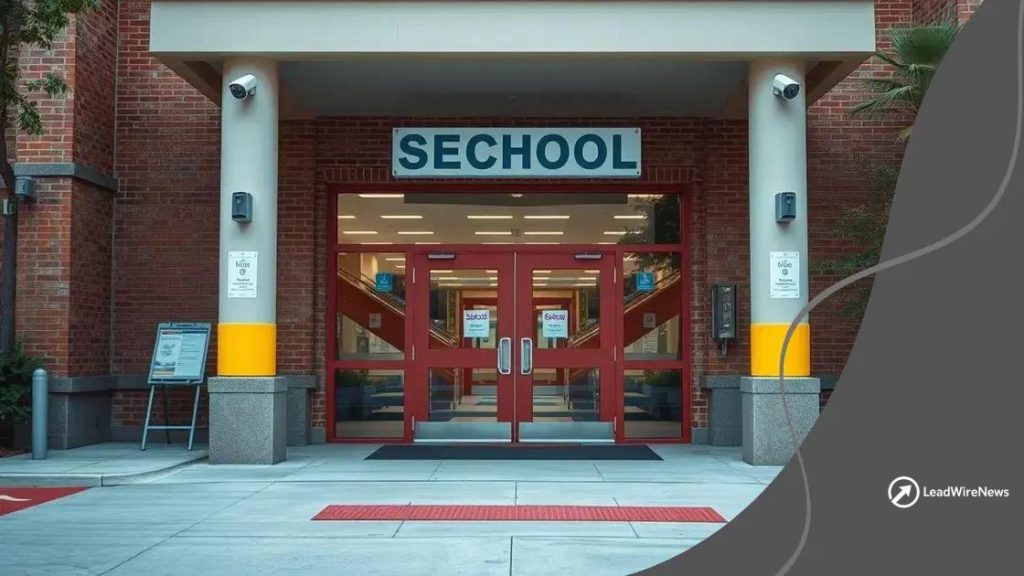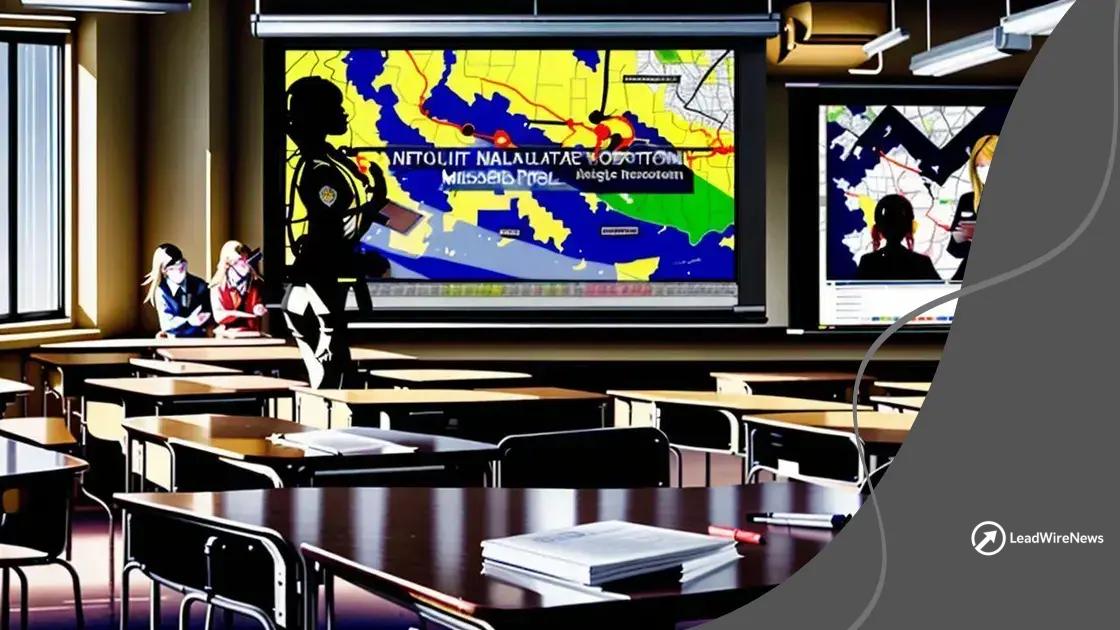School safety and security measures in focus

Anúncios
School safety and security measures focus on community involvement, effective communication, and the use of technology to create a safe learning environment for students and staff.
School safety and security measures are at the forefront of educational discussions today. Ever wondered how these initiatives can create a safer environment for students and staff? Well, let’s delve into what makes schools secure.
Anúncios
Understanding the importance of school safety
Understanding the importance of school safety is crucial for everyone involved in the educational system. Schools should be environments where students feel comfortable and secure. When safety measures are in place, both students and teachers can focus on learning and development without fear or distraction.
Why Safety Matters
Every school has a responsibility to protect its community. A secure environment not only enhances academic performance but also promotes positive social interactions. When students feel safe, they are more likely to engage and participate in school activities.
Implementing effective safety measures builds trust among students, parents, and teachers. It is essential for schools to evaluate their current safety protocols regularly.
Anúncios
Key Components of School Safety
- Access control: Limiting entry points and ensuring that visitors are checked can prevent unauthorized access to campuses.
- Emergency preparedness: Schools should conduct drills and prepare staff and students for various emergencies, including natural disasters and security threats.
- Environmental design: Structuring school layouts to enhance visibility and reduce hidden areas increases safety.
- Communication: Establishing clear channels for reporting concerns can help address safety issues before they escalate.
In addition to physical measures, fostering an inclusive culture can enhance school safety. Encouraging communication and respect among students helps build a community that looks out for one another. When students and teachers feel connected, they are more likely to report when something feels wrong, leading to earlier intervention.
School safety is not just about reacting to incidents; it’s about prevention and creating an atmosphere of support. By prioritizing safety, schools contribute positively to the overall wellbeing of their students.
Key security measures schools should adopt
Understanding the key security measures schools should adopt is vital for creating a safe environment. Implementing these measures helps protect students, staff, and school property. Effective safety protocols not only deter potential threats but also promote a sense of security among everyone on campus.
Access Control Systems
One of the primary steps in enhancing school safety is establishing proper access control. Schools can use various technologies to monitor who enters and exits the premises. This includes:
- Keycard entry: Use keycards for authorized personnel to access certain areas.
- Visitor management systems: Track visitors and check their identification before allowing entry.
- Exterior fencing: Secure school boundaries to limit unauthorized intrusions.
Each of these methods adds a layer of protection and ensures that only those with a purpose can enter the school grounds.
Emergency Preparedness Plans
Another critical aspect involves developing thorough emergency preparedness plans. These plans equip students and staff to respond effectively in various situations. Regular drills should be conducted to practice these procedures. Schools must prepare for:
- Fire emergencies: Evacuation plans and routes should be clear and practiced.
- Weather-related emergencies: Have protocols for tornadoes, floods, or severe storms.
- Intruder alerts: Implement a system for notifying authorities quickly in the case of a security threat.
By conducting drills and simulations, schools can train their community to stay calm and focused during real emergencies.
Collaboration with Local Authorities
Establishing strong relationships with local law enforcement and emergency services is essential for school safety. Regular meetings can help ensure that both the school and authorities understand safety protocols. Furthermore, having a police presence can deter criminal activities in and around school areas.
Additionally, schools should engage parents and the community in safety discussions. Promoting a culture of awareness fosters vigilance among everyone involved. A supportive community can help identify any suspicious activity and address potential threats promptly.
Creating a safety plan for emergencies

Creating a safety plan for emergencies is essential for every school. A well-structured safety plan prepares students and staff for potential threats or disasters, ensuring everyone knows their role in an emergency. Having clear procedures in place builds confidence and protects lives.
Identify Potential Risks
The first step in developing a safety plan is to identify possible risks that could affect the school community. This can include natural disasters, intruder situations, and medical emergencies. Once risks are identified, schools can better tailor their response strategies. Risk assessment helps provide focus and directs the attention of safety planners.
- Natural disasters: Analyze the likelihood of earthquakes, floods, or severe weather.
- Intruder alerts: Consider potential threats from outside or inside the school.
- Medical emergencies: Develop a plan for handling accidents or sudden health issues.
Understanding these risks enables schools to prepare and respond effectively to incidents.
Develop Communication Strategies
Effective communication is key during emergencies. Schools must establish clear lines of communication among staff, students, and parents. Utilizing multiple communication methods ensures that everyone receives timely information in stressful situations.
- Emergency alerts: Use text messages, emails, or phone calls to relay urgent information.
- Designated messaging platforms: Choose a reliable platform that all stakeholders can access quickly.
- Regular updates: Keep the community informed through updates about safety drills and procedures.
Involving parents in the communication plan enables them to stay informed and helps reinforce safety measures at home.
Training and Drills
Regular training and drills are key components of any safety plan. Conducting simulations prepares students and staff for various emergency scenarios, improving their responses in real situations. Training should encompass:
- Evacuation routes: Teach clear paths to safety and meet at designated points.
- Lockdown procedures: Train staff and students on securing the premises and staying quiet during intruder situations.
- First aid training: Equip staff with skills to handle medical emergencies promptly.
By practicing these procedures, schools can foster a culture of safety and preparedness. Regular reviews and updates to the safety plan ensure it remains effective and relevant.
The role of technology in enhancing security
The role of technology in enhancing security at schools is increasingly vital. Today’s technology provides innovative solutions that help ensure the safety of students and staff while creating a secure learning environment.
Surveillance Systems
One of the most significant technological advancements in school safety is the use of surveillance systems. Cameras installed in strategic locations help monitor the campus effectively. This real-time surveillance can deter criminal activity and quickly identify threats.
- 24/7 Monitoring: Continuous video recording allows security personnel to review incidents as they occur.
- Real-time alerts: Many systems can send immediate notifications to staff if suspicious activity is detected.
- Integrated systems: Cameras can be linked to alarms and access control systems for coordinated responses.
Making use of mobile monitoring apps also enables school staff to observe security feeds from their smartphones, ensuring safety from anywhere on campus.
Access Control Technology
Enhancing access control is another crucial aspect where technology plays a key role. Schools can implement electronic entry systems that limit access to authorized individuals only. This can significantly reduce the risk of unauthorized entry.
- Key card systems: Staff members can use key cards for secure entry into buildings.
- Biometric scanners: Advanced systems may include fingerprint or facial recognition technology.
- Visitor management systems: Electronic check-in systems enforce strict visitor protocols to ensure safety.
Such measures help maintain a secure environment while allowing for quick verification of who is on campus. Engaging parents and staff in the access control discussions can also strengthen community commitment to school safety.
Emergency Communication Tools
Technological solutions greatly enhance communication in emergencies as well. Having immediate access to communication tools allows for swift action during critical situations. Schools can adopt systems that enable:
- Mass notifications: Send out alerts to parents and staff quickly in case of emergencies.
- Mobile apps: Schools can use apps to communicate emergency protocols and updates in real-time.
- Automated alerts: Connect with local authorities to report incidents instantly.
By maintaining open lines of communication during emergencies, schools can provide timely and accurate information, contributing to a more organized response.
Involving the community in safety initiatives
Involving the community in safety initiatives is essential for creating a secure environment in schools. When parents, local businesses, and organizations work together, they strengthen the overall safety framework of the school. Community engagement fosters a collective responsibility towards ensuring that students thrive in a safe environment.
Building Partnerships
Establishing partnerships with local organizations is a productive way to enhance school safety. By collaborating with law enforcement, health organizations, and local businesses, schools can access additional resources and expertise. These partnerships can help with:
- Safety training: Local police can provide training sessions on handling potential threats and emergency procedures.
- Awareness programs: Community organizations can assist in developing programs that educate parents and students about safety practices.
- Resource sharing: Local businesses may offer materials or expertise at little or no cost.
Such partnerships not only improve safety protocols but also strengthen community ties.
Organizing Community Events
Holding community events centered around safety initiatives engages families and promotes conversation. Schools can host workshops, safety fairs, or open house events to discuss safety measures. During these events, families can learn about:
- Safety plans: Review the school’s emergency procedures and discuss how they can contribute.
- Safety resources: Introduce families to local experts who can share knowledge on various safety topics.
- Volunteer opportunities: Encourage parents and community members to participate in safety committees or patrol programs.
Engaging the community in this way creates a strong network of support that reinforces school safety.
Encouraging Open Communication
To involve the community effectively, schools must promote open communication. Providing platforms for parents to voice their concerns and suggest initiatives can lead to greater involvement. Schools can utilize:
- Surveys: Gather feedback from families regarding safety measures and improvements.
- Social media: Use social media pages to update the community on safety initiatives and engage in discussions.
- Regular meetings: Host community meetings to discuss safety issues and invite input from parents and residents.
By fostering a culture of open communication, schools can create trust and encourage ongoing collaboration. Making parents feel valued fosters bravery and encourages more stakeholders to participate actively.
FAQ – Frequently Asked Questions about School Safety and Community Involvement
How can parents get involved in school safety initiatives?
Parents can participate by joining safety committees, attending workshops, and providing feedback on safety measures.
What role do local organizations play in enhancing school safety?
Local organizations can provide resources, training, and support for safety programs and initiatives within schools.
Why is open communication important for school safety?
Open communication fosters trust and encourages the community to share concerns, ideas, and suggestions related to school safety.
How often should safety drills be conducted in schools?
Safety drills should be conducted regularly, at least once per semester, to ensure that students and staff are prepared for emergencies.